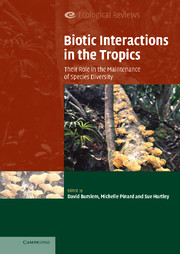Book contents
- Frontmatter
- Contents
- List of contributors
- Preface
- PART I Plant–plant interactions
- PART II Plant–microbe interactions
- PART III Plant–animal interactions
- 10 Implications of plant spatial distribution for pollination and seed production
- 11 Seed dispersal of woody plants in tropical forests: concepts, examples and future directions
- 12 The role of trophic interactions in community initiation, maintenance and degradation
- 13 Impacts of herbivores on tropical plant diversity
- 14 Have the impacts of insect herbivores on the growth of tropical tree seedlings been underestimated?
- 15 Multi-trophic interactions and biodiversity: beetles, ants, caterpillars and plants
- 16 The trophic structure of tropical ant–plant–herbivore interactions: community consequences and coevolutionary dynamics
- 17 Multitrophic interactions in a neotropical savanna: ant–hemipteran systems, associated insect herbivores and a host plant
- PART IV Biotic interactions in human-dominated landscapes
- Index
- References
14 - Have the impacts of insect herbivores on the growth of tropical tree seedlings been underestimated?
Published online by Cambridge University Press: 25 August 2009
- Frontmatter
- Contents
- List of contributors
- Preface
- PART I Plant–plant interactions
- PART II Plant–microbe interactions
- PART III Plant–animal interactions
- 10 Implications of plant spatial distribution for pollination and seed production
- 11 Seed dispersal of woody plants in tropical forests: concepts, examples and future directions
- 12 The role of trophic interactions in community initiation, maintenance and degradation
- 13 Impacts of herbivores on tropical plant diversity
- 14 Have the impacts of insect herbivores on the growth of tropical tree seedlings been underestimated?
- 15 Multi-trophic interactions and biodiversity: beetles, ants, caterpillars and plants
- 16 The trophic structure of tropical ant–plant–herbivore interactions: community consequences and coevolutionary dynamics
- 17 Multitrophic interactions in a neotropical savanna: ant–hemipteran systems, associated insect herbivores and a host plant
- PART IV Biotic interactions in human-dominated landscapes
- Index
- References
Summary
Introduction
Understanding the processes underpinning high biodiversity in tropical rain forests is a major goal for ecologists. There has been a long-standing interest in the role of herbivory in the tropics, in part because it has been proposed as a mechanism contributing to the maintenance of this diversity for tree species (Janzen 1970; Connell 1971; Marquis, Chapter 13, this volume). The Janzen–Connell hypothesis predicts that herbivore damage may act in a density-, distance- or frequency-dependent manner and, if the amounts of damage are sufficient to cause changes in growth rates or mortality of seedlings (or seeds), then this could lead to the distancing of conspecifics and hence promote species diversity. In areas of high conspecific density, increased herbivory could kill or reduce the growth of more common species, allowing rarer species to persist. This hypothesis relies on the ability of herbivory to significantly affect seedling growth or mortality, and although many studies have found variation in damage levels between species (Coley 1983; Coley & Barone 1996; Blundell & Peart 1998; Howlett & Davidson 2001), few studies have found conclusive effects on seedling growth, much less on mortality (Aide & Zimmerman 1990; Webb & Peart 1999; Howlett & Davidson 2001; Horvitz & Schemske 2002; Hyatt et al. 2003; Pearson et al. 2003b). Of the studies that have demonstrated differences in growth rates or mortality between species caused by herbivory (Marquis 1984; Coley 1986; Bazzaz et al. 1987; Sork 1987; Osunkoya et al. 1993; Terborgh & Wright 1994; Sagers & Coley 1995; Whitmore & Brown 1996; Ickes et al. 2001; Wallin & Raffa 2001), the majority are attributable to mammalian herbivores and seed predators (Sork 1987; Osunkoya et al. 1993; Terborgh & Wright 1994; Ickes et al. 2001).
- Type
- Chapter
- Information
- Biotic Interactions in the TropicsTheir Role in the Maintenance of Species Diversity, pp. 347 - 365Publisher: Cambridge University PressPrint publication year: 2005
References
- 4
- Cited by



